A Large Voltage Responsivity Pyroelectric Sensor Based on Hot-Pressed Lead Zirconate Titanate Ceramic
Abstract
1. Introduction
2. Materials and Methods
3. Results and Discussion
4. Conclusions
Author Contributions
Funding
Institutional Review Board Statement
Informed Consent Statement
Data Availability Statement
Conflicts of Interest
References
- Putley, E.H. Chapter 6 The Pyroelectric Detector. In Semiconductors and Semimetals; Elsevier: Amsterdam, The Netherlands, 1970; Volume 5, pp. 259–285. [Google Scholar] [CrossRef]
- Cooper, J. A Fast Response Total-Radiation Detector. Nature 1962, 194, 269–271. [Google Scholar] [CrossRef]
- Mitmit, C.; Goldenberg, E.; Tan, E.M.M. Infrared Wavelength-Specific Gas Sensing with Pyroelectricity at Room Temperature. Sens. Actuators A Phys. 2023, 351, 114164. [Google Scholar] [CrossRef]
- Zhao, J.; Zhu, R.; Chen, J.; Zhang, M.; Feng, P.; Jiao, J.; Wang, X.a.; Luo, H. Enhanced Temperature Stability of Compensated Pyroelectric Infrared Detector Based on Mn:PMN-PT Single Crystals. Sens. Actuators A Phys. 2021, 327, 112757. [Google Scholar] [CrossRef]
- Aleksandrova, M.; Jagtap, C.; Kadam, V.; Jadkar, S.; Kolev, G.; Denishev, K.; Pathan, H. An Overview of Microelectronic Infrared Pyroelectric Detector. Eng. Sci. 2021, 16, 82–89. [Google Scholar] [CrossRef]
- Li, Z.; Liu, F.; Tang, Y.; Zhao, X.; Wang, T.; Duan, Z.; Shi, W.; Wang, F.; Jiao, J.; Luo, H. Compensated Pyroelectric Infrared Detector Based on Mn-Doped PIMNT Single Crystal with Enhanced Signal Stability. J. Am. Ceram. Soc. 2020, 104, 995–1001. [Google Scholar] [CrossRef]
- Wu, Q.; Li, X.; Yang, X.; Xu, B.; Wang, Y. Pyroelectric Infrared Device with Overlap Dual Capacitor Structure Sensor. Sens. Actuators A Phys. 2018, 282, 192–196. [Google Scholar] [CrossRef]
- Zeng, X.; Luo, W.; Zhang, K.; Huang, S.; Shuai, Y.; Hao, X.; Wu, C.; Zhang, W. Wafer-Scale Fabrication of Silicon-Based LiTaO3 Pyroelectric Infrared Detectors by Bonding and Thinning Technology. IEEE Sens. J. 2022, 22, 17721–17726. [Google Scholar] [CrossRef]
- Odon, A.; Szlachta, A. Voltage Response of a Pyroelectric Detector to a Single Rectangular Optical Radiation Pulse. Sensors 2022, 22, 6265. [Google Scholar] [CrossRef] [PubMed]
- Ranacher, C.; Consani, C.; Tortschanoff, A.; Rauter, L.; Holzmann, D.; Fleury, C.; Stocker, G.; Fant, A.; Schaunig, H.; Irsigler, P.; et al. A CMOS Compatible Pyroelectric Mid-Infrared Detector Based on Aluminium Nitride. Sensors 2019, 19, 2513. [Google Scholar] [CrossRef]
- Liang, Z.; Li, S.; Liu, Z.; Jiang, Y.; Li, W.; Wang, T.; Wang, J. High Responsivity of Pyroelectric Infrared Detector Based on Ultra-Thin (10 μm) LiTaO3. J. Mater. Sci. Mater. Electron. 2015, 26, 5400–5404. [Google Scholar] [CrossRef]
- Yu, P.; Ji, Y.; Neumann, N.; Lee, S.G.; Luo, H.; Es-Souni, M. Application of Single-Crystalline PMN-PT and PIN-PMN-PT in High-Performance Pyroelectric Detectors. IEEE Trans Ultrason. Ferroelectr Freq Control. 2012, 59, 1983–1989. [Google Scholar] [CrossRef] [PubMed]
- Whatmore, R.W.; Watton, R. Pyroelectric Ceramics and Thin Films for Uncooled Thermal Imaging. Ferroelectrics 2000, 236, 259–279. [Google Scholar] [CrossRef]
- Whatmore, R.W.; Zhang, Q.; Shaw, C.P.; Dorey, R.A.; Alcock, J.R. Pyroelectric Ceramics and Thin Films for Applications in Uncooled Infra-Red Sensor Arrays. Phys. Scr. 2007, T129, 6–11. [Google Scholar] [CrossRef]
- Porter, S.G. A Brief Guide to Pyroelectric Detectors. Ferroelectrics 1981, 33, 193–206. [Google Scholar] [CrossRef]
- Whatmore, R.W. Pyroelectric Devices and Materials. Rep. Prog. Phys. 1986, 49, 1335–1386. [Google Scholar] [CrossRef]
- Liu, S.T. Critical Assessment of Pyroelectric Detectors. Ferroelectrics 1976, 10, 83–89. [Google Scholar] [CrossRef]
- Whatmore, R.W.; Ward, S.J. Pyroelectric infrared detectors and materials—A critical perspective. J. Appl. Phys. 2023, 133, 080902. [Google Scholar] [CrossRef]
- Mahler, R.; Phelan, R., Jr.; Cook, A. High D∗, Fast, Lead Zirconate Titanate Pyroelectric Detectors. Infrared Phys. 1972, 12, 57–59. [Google Scholar] [CrossRef]
- Thakur, O.P.; Singh, J.P.; Prakash, C.; Kishan, P. Modified Lead-Zirconate-Titanate for Pyroelectric Sensors. Def. Sci. J. 2007, 57, 233–239. [Google Scholar] [CrossRef][Green Version]
- Qiu-lin, T.; Wen-dong, Z.; Chen-yang, X.; Ji-jun, X.; Jun, L.; Jun-hong, L.; Ting, L. Design, Fabrication and Characterization of Pyroelectric Thin Film and Its Application for Infrared Gas Sensors. Microelectron. J. 2009, 40, 58–62. [Google Scholar] [CrossRef]
- Taniguchi, Y.; Murakami, K.; Kobayashi, H.; Tanaka, S. Pyroelectric Infrared Sensor Using PZT Thin Plate on Diaphragm as Sensitive Elements. Electron. Commun. Jpn. (Part II: Electron.) 1996, 79, 86–96. [Google Scholar] [CrossRef]
- Wu, Z.; Zhang, M.; Jiang, X.; Ke, X.; Cai, Y.; Cao, L.; Li, J.; Jia, H.; Li, C.; Leung, C.M.; et al. Lead-Free Pyroelectric Infrared Detector Based on (Bi1/2Na1/2)TiO3-BaTiO3 Ferroelectric Ceramics. J. Am. Ceram. Soc. 2023, 106, 6755–6761. [Google Scholar] [CrossRef]
- Eaton, J.W. GNU Octave. Available online: https://www.octave.org/ (accessed on 16 December 2024).
- inraTec. LME-551-# Single Channel Pyroelectric Detector. Available online: https://www.infratec.cn/sensor-division/single-channel-detectors/ (accessed on 16 December 2024).
- BROADCOM. Thin Film Pyroelectric Flame Sensor. Available online: https://docs.broadcom.com/doc/AFBR-S6ATO1FL-DS (accessed on 16 December 2024).
- Excelitas. Infrared Sensing Solutions New, Updated Edition 4.1. Available online: https://www.excelitas.com/cn/product-category/pyroelectric-ir-detectors-and-sensors (accessed on 16 December 2024).
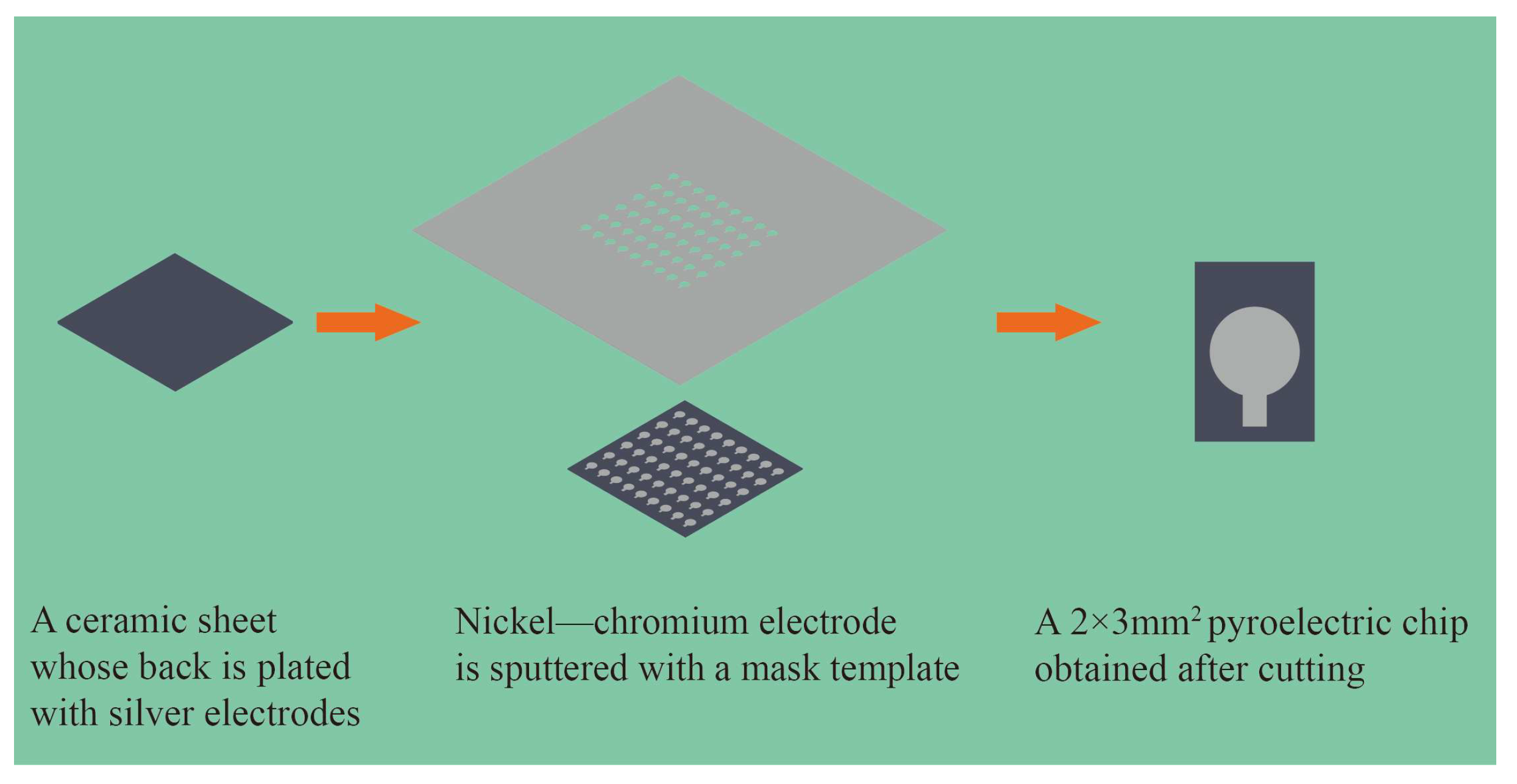
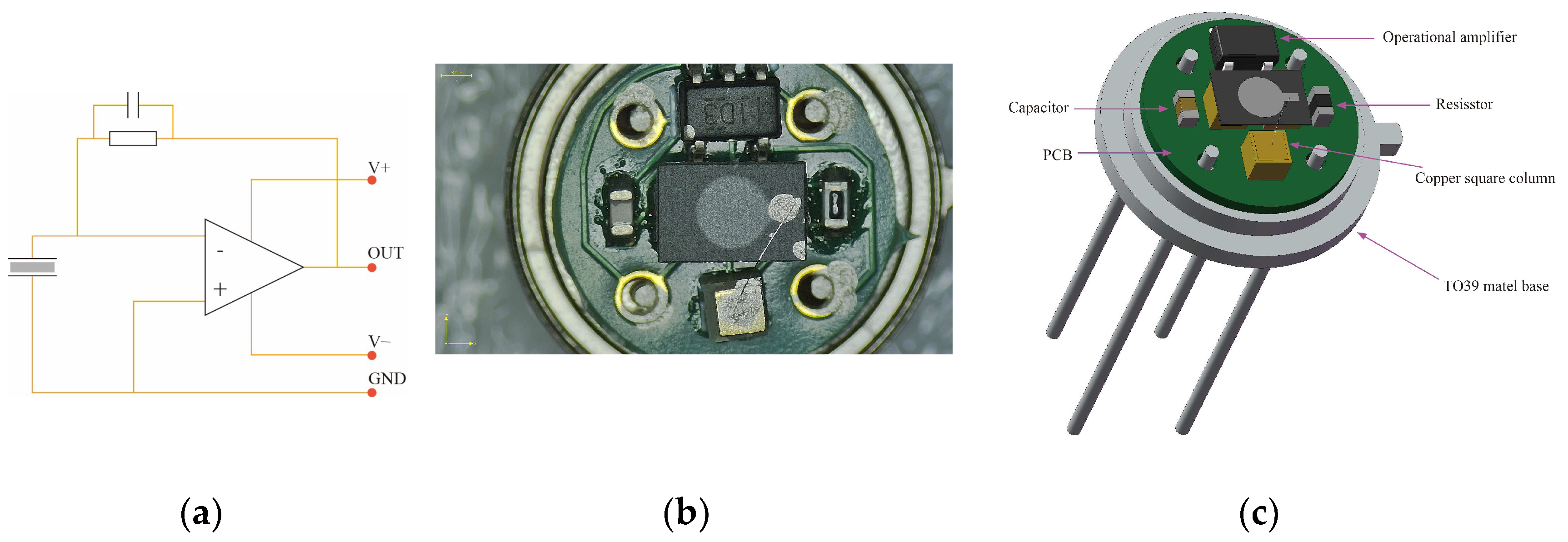


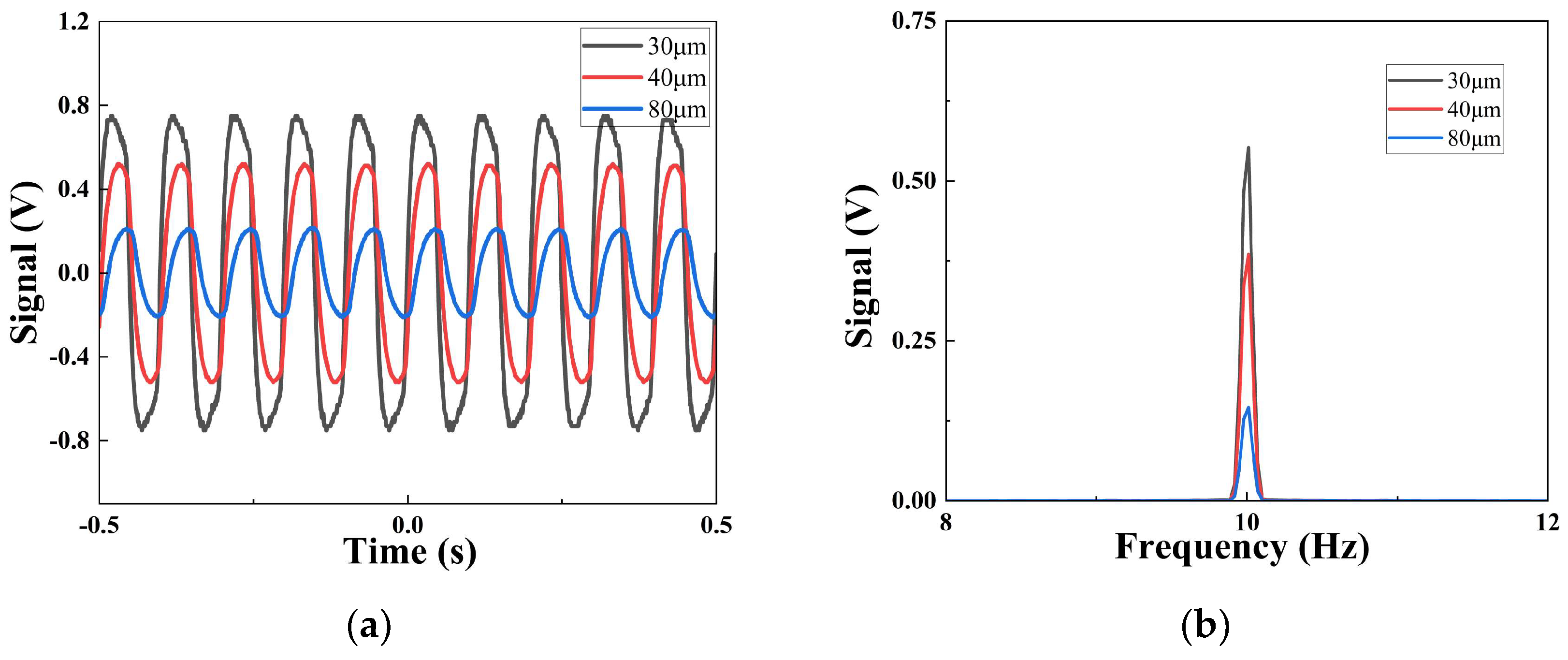
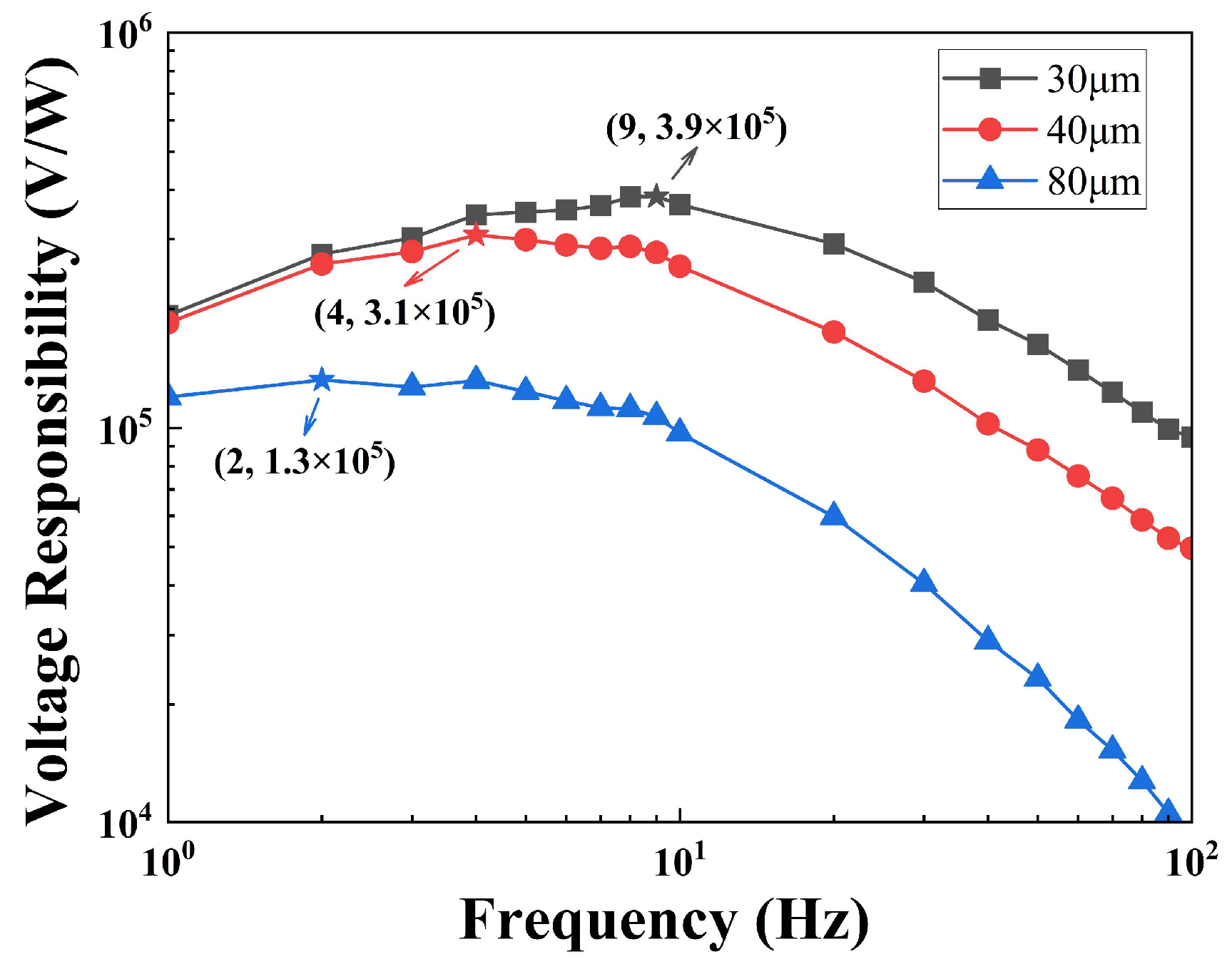

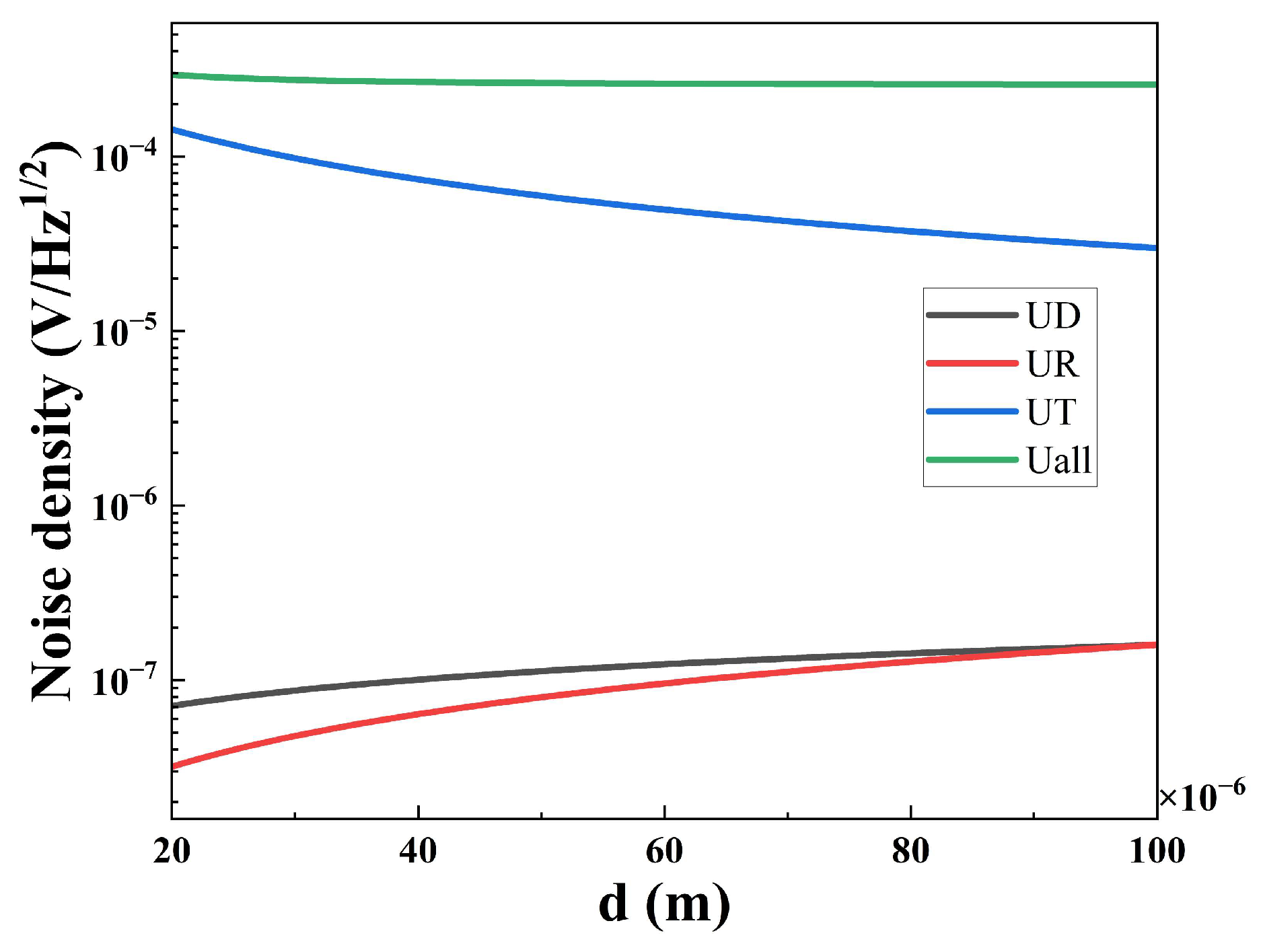
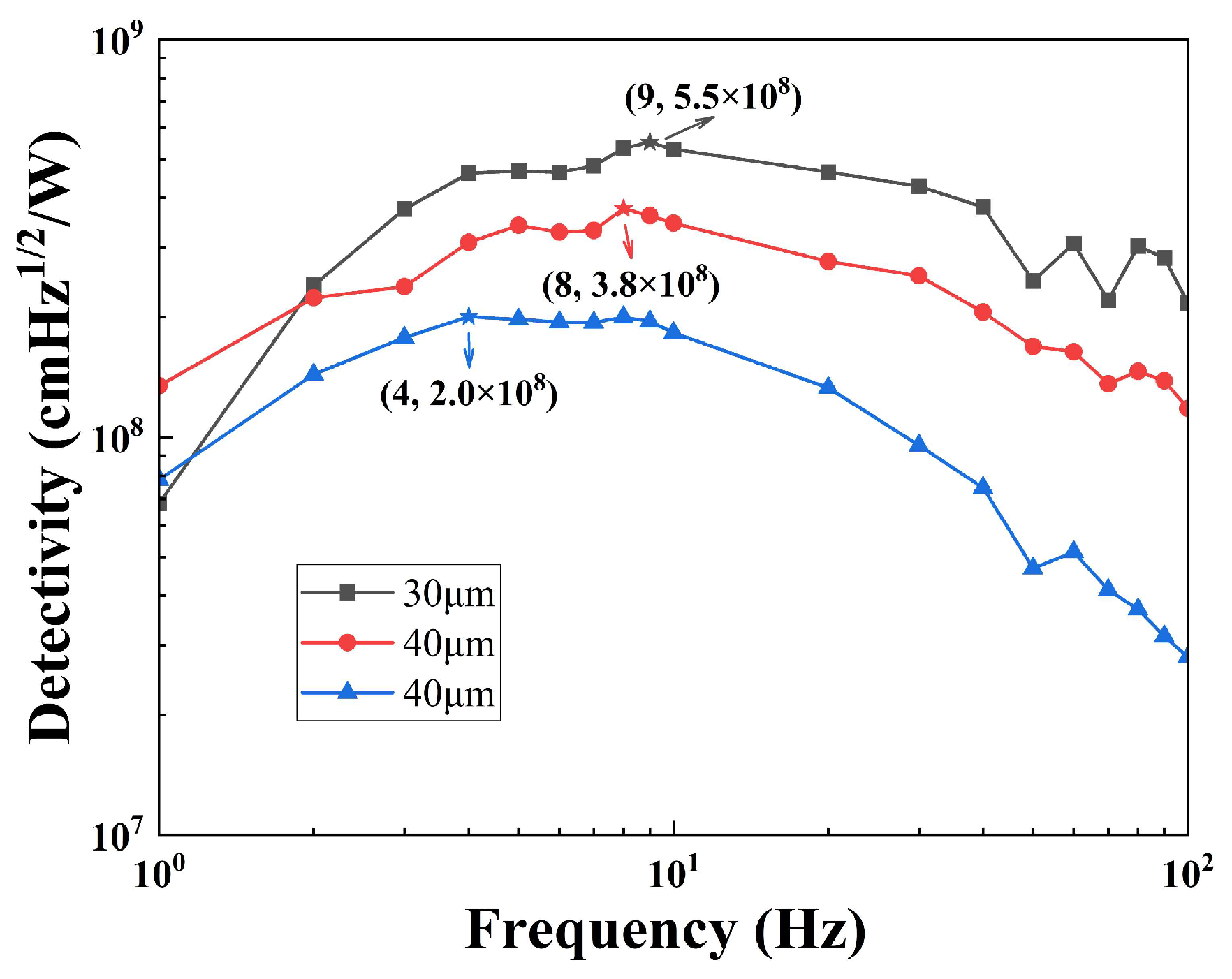
| Physical Properties | Value |
|---|---|
| Pyroelectric coefficient () | 4.5 × 10−4 C/m2K |
| Curie temperature () | 234 °C |
| Relative dielectric constant () | 300 (@1 kHz) |
| Resistivity () | 1.1 × 1012 Ω·cm |
| Dielectric loss () | 0.0045 (@1 kHz) |
| Volumetric heat capacity () | 2.638 × 106 J/m3·K |
| Corporate | Model | Type | Pyroelectric Material | Voltage Responsivity | Specific Detectivity |
|---|---|---|---|---|---|
| InfraTec [25] | LME-551 | Current mode | LT | 6000 | 2.5 × 108 |
| BROADCOM [26] | AFBR | Current mode | PZT thin films | 150,000 | 3.5 × 108 |
| Excelitas [27] | PYD | Voltage mode | PZT ceramics | 42,000 | / |
| This work | 30 μm-sensor | Current mode | PZT ceramics | 367,700 | 5.3 × 108 |
Disclaimer/Publisher’s Note: The statements, opinions and data contained in all publications are solely those of the individual author(s) and contributor(s) and not of MDPI and/or the editor(s). MDPI and/or the editor(s) disclaim responsibility for any injury to people or property resulting from any ideas, methods, instructions or products referred to in the content. |
© 2025 by the authors. Licensee MDPI, Basel, Switzerland. This article is an open access article distributed under the terms and conditions of the Creative Commons Attribution (CC BY) license (https://creativecommons.org/licenses/by/4.0/).
Share and Cite
Guo, Y.; Guo, S.; Yao, C.; Pan, Z.; Wang, G. A Large Voltage Responsivity Pyroelectric Sensor Based on Hot-Pressed Lead Zirconate Titanate Ceramic. Sensors 2025, 25, 917. https://doi.org/10.3390/s25030917
Guo Y, Guo S, Yao C, Pan Z, Wang G. A Large Voltage Responsivity Pyroelectric Sensor Based on Hot-Pressed Lead Zirconate Titanate Ceramic. Sensors. 2025; 25(3):917. https://doi.org/10.3390/s25030917
Chicago/Turabian StyleGuo, Yanhao, Shaobo Guo, Chunhua Yao, Zhiwei Pan, and Genshui Wang. 2025. "A Large Voltage Responsivity Pyroelectric Sensor Based on Hot-Pressed Lead Zirconate Titanate Ceramic" Sensors 25, no. 3: 917. https://doi.org/10.3390/s25030917
APA StyleGuo, Y., Guo, S., Yao, C., Pan, Z., & Wang, G. (2025). A Large Voltage Responsivity Pyroelectric Sensor Based on Hot-Pressed Lead Zirconate Titanate Ceramic. Sensors, 25(3), 917. https://doi.org/10.3390/s25030917






